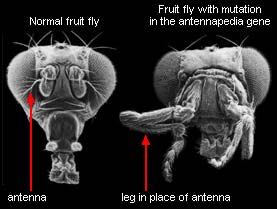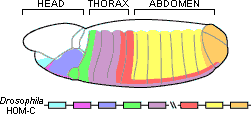The study of development has revealed that animals in groups as diverse as insects and humans share genes that direct certain stages of development. Homeotic genes determine the identity of body regions in early embryos. These regulatory genes control when and where other genes get turned on. For example, eye cells turn on the genes that make proteins necessary for vision, but the cells lining the digestive tract don't turn on these genes. Instead, they turn on genes that synthesize digestive enzymes.
Homeotic genes turn on the right genetic program to make sure, for example, that a fly's thorax carries legs while its head does not. When these genes are inactivated or expressed in unusual locations due to mutations, they cause changes in patterns of body parts sometimes causing startling effects such as an entire leg growing in place of antennae (see below) or an extra set of wings.

Developmental biologists are finding that the same homeotic genes direct the development of structures in diverse groups of animals. Body segmentation is present in both arthropods and vertebrates. In the past, this observation has been explained as a case of convergent evolution. It now appears that the same gene regulates the development of segmentation in both groups, which means that body segmentation was probably present in a common ancestor of both groups. The study of evolution through the analysis of development is sometimes called "evo-devo" and is revealing that a relatively small set of common genes underlies basic developmental processes in many organisms. Evo-devo is helping to explain how small changes in these development-directing genes can have far-reaching evolutionary consequences.

Different segments of the developing fly embryo express different genes.